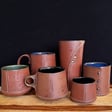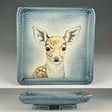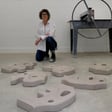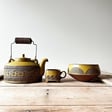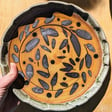Introduction to Pottery Insights
00:00:00
Speaker
Hey, real quick before we get started, if you want to dive deeper into the techniques and the lessons I've learned from the potters I've interviewed, come join the Shaping Your Pottery newsletter to dive deeper and learn more about pottery. Go to shapingyourpottery.com forward slash newsletter or click the link in the description.
Meet Maria Laura: Inspirations and Challenges
00:00:17
Speaker
Have you ever wanted to learn how to add textures to your own pottery? Well, so did I. And in today's interview, I got to interview Maria Laura. And Maria spent two and a half years learning how to do just that, learning how to add textures to her own pottery. Maria is inspired by Japanese ceramics and the cosmos, and she uses these inspirations to help impact the way she makes her own pottery.
00:00:40
Speaker
In this episode, you will learn how Maria makes textured pottery. You also learn the biggest mistakes when trying to add texture to your own pottery. And of course, in the latter half of the of the episode, you will learn how to discover your own unique voice with your pottery. Hope you guys enjoy this episode and I'll see you guys in there.
00:01:01
Speaker
If you love pottery and want to take your skills to the next level, you're in the right place. Find your own pottery style right here on Shaping Your Pottery with Nick Torres. Let's get started.
Maria's Pottery Journey Begins
00:01:12
Speaker
Maria, welcome, shape your pottery and share with me what is something everyone in the pottery industry is trying to do that you discovered a better way to do I think the most the most curious thing that I've discovered is how to create different types of textures. I'm obsessed with textures, and I think that's what I do the best. Not the best of all, but the best at what I've ever tried before. Love that. And we'll talk more about your pottery and your texture in just a little bit. But for now, tell me the story how you got started making pottery.
00:01:42
Speaker
Yeah, it wasn't actually that long ago. About two and a half, three years ago, I've gone through divorce and through changing my life entirely. I've changed where I lived. I've changed my partner. I've changed my hobbies. I've changed so many different things.
00:01:59
Speaker
And I think during this transition, I've rediscovered my love towards art. And I just accidentally found a beautiful cup that I liked and I wanted to make something like that. And the step towards making my own pottery was very scary. I got a used wheel for like 100 bucks off the Facebook marketplace. And for me, that was a very important step but very big because I don't like buying new things in general and buying something that I'm potentially not gonna use ever again is scary but I've used it and my husband my new husband supported me a lot and that he just kind of just told me just yeah just give it a try it's okay if you fail don't worry about it but it feel felt like the right thing to do
00:02:49
Speaker
Then I started taking courses in local community studios. I went to community college and it just kept rolling since then. So how did getting back into art just help you out in general?
00:03:03
Speaker
i I think I found my passion in life. I think that's a big thing. Before I found ceramics, I've been kind of the Renaissance woman. I've done everything. I've been working as a tutor for the last 12 years, and I've taught everything, like every single subject. So I really like to dig into the topic, really research it very deeply.
00:03:27
Speaker
and then teach it to other people. And I've just been jumping through subject by subject, by subject by subject, ah some interest, other interest, this hobby, that hobby. And when I found ceramics, it just all hit into one big point where I am right now. And I went deep finally. So I think that's my favorite thing about it. I finally could focus on one fee and develop my skills a lot deeper.
00:03:54
Speaker
Absolutely love that.
Cub Creek Residency Experience
00:03:56
Speaker
So tell me the story about when you decided to attend the Cub Creek residency. Thanks to my community college, we have a wonderful professor who is very good at getting grants. She got us a grant to go to the Enceca conference, so we got funded to go there. And at the Enceca conference, i I knew that Zoe Paul is going to give a talk about ah natural resources and wild clay.
00:04:24
Speaker
And she said, oh, come say hi. And so I came and said hi to her desk with like a lot of flyers. And she ended up ah being at the desk where cup cresidency was represented. So that was the first table that I approached. I took the flyer, I looked at it, and I'm like, OK, that looks like the residency that I'm going to get in. For some reason, I just felt it.
00:04:49
Speaker
and i've After that I've piled up a whole list of residences and I checked all of them and I was going to apply to all of them but then I ended up applying to just this one and the other one and I got into Cub Creek Residency so it was kind of just all again just coming into the right spot at the right moment and there were the right people. What were you feeling when you got into the Cub Creek Residency?
00:05:13
Speaker
Excited, excited for sure. And also just calm. I feel like it was meant to be, I think that was the perfect time in my career. It was also the perfect topic. They, for those who don't know about the residency, it's in the middle of nowhere in Virginia. And the founder, John Jessaman, he worked as a professor at Alfred for many, many, many years. And then he retired and acquired the big, big property where he invited many people, many artists, especially emerging artists to develop their careers and their skills. And most importantly, to try wild clay and natural materials, as well as wood firing. And so obviously wood firing attracted me a lot because it's just something that you have to be very interested to get into it because there's limited opportunities of that.
00:06:04
Speaker
How did your time here impact the way you make your
Natural Materials and Textures Exploration
00:06:07
Speaker
own pottery? I i think there was again a natural continuation of what I was interested in. I was really interested in textures, in Japanese ceramics, in everything that looks wabi-sabi.
00:06:21
Speaker
From the very, very beginning of where I started, I knew that that's the kind of aesthetics that attracts me. um And finally, I was able to actually use the appropriate tools to get to the aesthetics that I liked. So it just fit my practice really well. i Unfortunately, wood firing is not available to me right now, but even that is not really a big issue. I know that I'm going to find world killings again. I might even build my own at some point in the future whenever I settle at some place. But using wild clay, using natural materials, rocks, ah sands, and other foraged materials that are place specific is something that I'm working with right now. And I'm having a lot of fun with it.
00:07:11
Speaker
Absolutely love that. So what is something you learn during your time at this residency that you still use today? Natural materials. Yeah, I foraged some of the clays and some of the rocks. I crushed them right there at the residency and brought them with me to California. And I am actually literally using the things that I took from there in my practice. um But outside of that, it was just my full exposure to beginning to work with natural materials. I've been to several workshops before.
00:07:43
Speaker
but I've never actually started to apply it to my own practice and now it's just another tool in my toolkit to how I like to achieve various textures that I enjoy. Where do people find these natural resources for their pottery?
00:08:01
Speaker
It's a good question. There is a whole topic of ethics of how to forage the materials ah because some of the places and some of the places it's forbidden to forage them, for example, national park or mark parks or various protected areas. So ideally, because in the US, at least all land is owned by anyone or by someone, we have to ask the person who owns the land whether we can forage it there or not.
00:08:26
Speaker
ah But it could be your neighbor, a lot of construction sites, a lot of people who have property, they have clay and rocks on their property, yeah or maybe you have a property and you have clay and you don't even know about it so a lot of it. There's a lot of places like that where we can forage materials, but we do need to remember about it being ethical towards the people who legally own the land and towards the land itself, whether it's Whether it's the land that has a spirit or it's a land as an ecosystem that we might potentially damage or destroy. Either way, I think it's a lot more sustainable way to gather materials than to be part of the mining and shipping and global exchange network.
Philosophical Influences on Pottery Style
00:09:13
Speaker
Absolutely love that shape nation if you're thinking about looking for your own materials for your pottery Remember to be mindful of the property and the place that you're you're trying to get the materials from absolutely love that Yeah, so let's talk about your pottery Tell me the story how you started making your spherical and textured vases that you make today ah Yeah, I um was thinking about it lately and I think there's a lot of layers to why I'm making spheres and why I'm making textures. The important part is the shape. I like it from a technical side. I think making moon jars and spheres is challenging but very rewarding. It's just a very fun shape to make.
00:09:58
Speaker
I make them on the wheel. I like that I can do it quickly. I don't have to worry about symmetry and they just come out to be spherical, so I really enjoy that. However, there is a lot more depth into it. There is a lot of philosophy in it and a lot of my prior interests. I was really interested in astrophysics and space for a very long time before I started ceramics. It was one of the subjects that i really loved digging into and exploring i was just really fascinated by the vastness of space by the cosmos by how far the stars are from us by what happens if you get into black hole and a lot of the
00:10:43
Speaker
shapes in the universe are spherical because of the gravity and because of how the universe is structured. So I think some of it just like clicked into my ceramics and came out to be the aesthetics of spherical shapes.
00:10:59
Speaker
The other thing that I think is also involved, and that might be ah just me thinking through it after I already started making, but for the recent three or four, i've that's kind of jumping into the more question of what I'm inspired by. And I've been in yoga and different meditation practices since I was 19.
00:11:25
Speaker
But only in the last three or four years I've gotten more and more into a non-dual philosophies. And for those who don't know about them, there are several branches of Buddhism and Hinduism that focus on the lack of the boundary between the self and the world around. And they talk a lot about the illusion of ego and the illusory nature of the self. And that really resonated with me at some point because I had this embodied experience of it.
00:11:54
Speaker
And I think it also is reflected in my vessels. The vessels themselves are kind of the carriers of whatever is inside, but whenever I make the vessels, they're empty on the inside, so there's not really anything on the inside to kind of hold on to.
00:12:10
Speaker
but the vessel itself is round and they all look kind of similar but they're all different at the same time so they have different texture and I feel like that's a really nice reflection of how we as people are all different because we're kind of made from different materials or on the surface we have various hobbies and different lives but on the inside we're all still the same and we still have a lot in common.
00:12:38
Speaker
So long, long answer. And there's, there's a lot hidden behind this fear, I think it's just such a deep shape and deep idea. Absolutely love that. So now why do you like adding texture to your own pots?
00:12:55
Speaker
I think it's because I've limited myself in form intentionally so or intentionally or unintentionally. I think because I'm interested in it from the visual perspective, in the spherical shape.
00:13:09
Speaker
I for some reason just came to not making other forms as often and focus on the surface instead and on the texture. I think the other reason is that for a very long time I was very um not attracted by shiny traditional glazes and pottery. I'm kind of changing my opinion now but I feel like I just had a very strong opinion about it and I think now I understand that it's okay, we all have different perspectives, we there's also different categories of ceramics, there's ceramic art that looks like this, there's ceramic art of that category, etc. So I'm kind of in peace right now with all the kinds of ceramics, but before I felt like really strongly I was really into matte textures, I was really into textures, not like glossy shiny things.
00:13:59
Speaker
And I think that what probably brought me to lava glazes and to various natural materials as well and to various techniques of how I create textures. Love that. Shaping Nation, we're all going to have different perspectives about our pottery and something that somebody else is doing, may you may not like and that's okay, but it matters what does matter is you find what you do like. Absolutely love that. Yeah.
Creating a Texture Course for Ceramics
00:14:23
Speaker
So right now you are creating a course all about adding different textures and ceramics. Tell me more about this. Yeah, it's been a wonderful journey. I've been developing this course for the last couple of months and finally it's coming to the end and I am almost done filming. I'm done filming and editing the first part and I am currently working on the part on glazes.
00:14:50
Speaker
It's a wonderful course. It's just a lot of people started asking me, oh, how do you do this? How do you do that? But the thing is I can't give one answer because I combine in like 20 or 30 different techniques. And I felt like a comprehensive course that covers a lot of various ideas and scenarios of how you can add texture would be a lot better than just saying like, oh, I'm using slip or that's a lava glaze or whatever. Like that's kind of.
00:15:17
Speaker
I feel like if I give people a whole list of techniques, that would be much easier for them to use, which ones are appropriate for them, which ones they can use in their studio practice. whether it's ah It depends on a lot of things. It depends on the access to appropriate kiln, on whether people are ready to work with raw materials or not, whether they want to fire rocks in their kiln or metal. you know There's various restrictions, but the possibilities are limitless.
00:15:45
Speaker
So we' we're launching or we, I am launching on October 28th and that's going to be the first date of the the first week of my course. The course is divided into two parts. The first part is going to be glaze free. So no mixing raw materials. It's just working with slips, working with forage materials with various clay particles and things like that. And so using.
00:16:11
Speaker
whatever we can find around us to create textures. And then the second part is highly influenced by Matt Katz and his ceramic materials workshop. I really love his approach to glazing and it influenced my practice a lot because I'm sciency myself and I love when things are done through actual chemistry. And Matt is doing a really good job about that. And so a lot of it is inspired by his course. A lot of it is my own exploration. So I'll share kind of the basics of how people can mix their own glazes. And a whole chunk of this part will be focusing on the textured glazes in particular, and also textured slips. So everything like lava, lichen, and crackled slips, and things like that will be in my course.
00:17:03
Speaker
Absolutely love that. it Sounds like an amazing course. I think it'll be fun. What do you think are some of the most common mistakes people make when trying to add textures to their pottery? Good question. I think they probably don't experiment for long enough. I think that's my answer to this question. And in general, I think to a lot of questions, I can just say, be consistent and just do it until you get the result you want. ah When I started, I tried various things. I even tried mixing my own lava for a very long time.
00:17:36
Speaker
And I've struggled. I've had so many problems. like Starting with the company that I ordered silicon carbide from, that's the main ingredient that creates bubbles, they sent me silica.
00:17:49
Speaker
like some just silica instead. And I had no idea. I just started then. I didn't even know that silicon carbide was supposed to be black and not white, you know, things like that. I i mixed so many different recipes. None of them worked and I didn't know why. So I had to like figure out literally every single step on my own of why they do not work and why they work. And it takes time. It takes time to develop up the style you want, it takes time to get the results you want because that's that's the hardest part about having a vision in your head and then connecting it to the level of skill and mastery to be able to fulfill it in reality.
00:18:28
Speaker
So I think that and consistency is the answer. Agree shaping nation. Sometimes if you have an idea in your head, you have to spend more time than you might think to actually make that idea come to life. You have to spend a lot of time to make that mastery come to life and be consistent as well. I absolutely love that. So now can you briefly walk me through the steps you take when you are adding textures onto your own pots?
00:18:53
Speaker
That's hard to tell because there are so many different techniques. So I think you would have to take my course, unfortunately. And the course is many, many hours long. So you'll have to ah go through all of this. ah Briefly, I choose the techniques I like. I choose the materials I want to use, whether it's slip or some forest materials or it's glazes. And then I go from there. I just layer them up or I use one or two of them. And as a result, I create textures.
00:19:22
Speaker
That's all. Absolutely love that.
Balancing Recognition and Personal Satisfaction
00:19:25
Speaker
So let's talk about discovering your voice. Can you tell me about the moment when you knew you were heading in the right direction with your pottery? I think unfortunately or fortunately it all comes to ah recognition from the outside. Because on the inside within me I already knew how I wanted my pottery to look like for a very long time and I was kind of satisfied with that. I i kind of just knew that that's the aesthetics I like. I could have just stopped there.
00:19:55
Speaker
But very slowly I started matching these two. I started matching whatever I envisioned and what I could make. And more and more often I got the results that I actually really enjoyed and that I i envisioned.
00:20:10
Speaker
But then even that, I think when that happens, when this connection between what needs to be realized in this world and the actual physical object, when that happens, I think the world recognizes it. And I think people see that, oh, those pieces are unique and those pieces reflect who I am, at least to a certain extent.
00:20:34
Speaker
And so I think that's probably a good sign that it's happening. When you like it as an artist and when other people recognize that, yeah, this is definitely your style and this is definitely something that reflects you, ah whether you as a person, you as an artist or just your vision. Absolutely love it. Definitely agree. What were you feeling when your voice started actually coming true and other people started noticing it as well?
00:21:01
Speaker
Also good question. I've thought about it recently and I've realized that I am not feeling any different about myself as a person or as an artist or whether I'm successful or not. So it didn't really satisfy my ego. That's illusory. Anyway, it was more like a feeling of me finally coming to the surface, if that makes sense. Like this me existed at all times, but finally and It just like is in the world if that makes sense. So I was kind of like more getting closer and closer to Who I am If that makes sense, I absolutely love that shaping nation. You already have a voice out there It's just about finding what works for you and bringing that voice and making it come to life. Yeah, I absolutely love that What would you say was your biggest obstacle when it came to finding your own voice? I
00:21:57
Speaker
i think i actually don't know let me think i think that It's the process itself is very slow. So I think that what I don't like. And I think I've always been frustrated with things not going as quickly as I'd like. And unfortunately, this kind of things take time. It takes time to first of all, develop the mastery, develop the craft. And while I'm not there, I kind of have enough tools and enough skill to be able to realize what I want. I think.
00:22:33
Speaker
just in general, the fact that I had to be consistent, that I had to work and work and work and not see the results I wanted for a very long time, while in my head I already imagined a completely different picture. And so I feel like now I'm at a place where I'm more or less satisfied with the speed with which I'm developing, and that feels much better than in the very beginning, where I just couldn't catch up with my own ideas, with my own ambitions, you can say.
00:23:01
Speaker
There was something else that I wanted to add, but that's okay. I absolutely love that. Shapedation, finding your voice is going to be a little bit slow at first, but once you find it, and once you're able to build up your skills, your trajectory becomes a lot faster. I absolutely love that. So now what advice would you give to someone looking to discover their own unique voice with their pottery?
00:23:26
Speaker
I think there are several things that people can do. I think ah at least i've had I've had it kind of divided in my head in several steps as the result of this whole process. I think the first step was to to recognize what I like and to kind of become familiar with what kind of aesthetics I'm drawn to. And sometimes it might even involve being resistant to it at first. So maybe we hate something at first, but then we realize that, oh, no, that I hate it because I actually want to do it. Or maybe it's something that's just silly. Like, for example, I was, for some reason, concerned about making black items. I don't know. It just like seemed dark or whatever. But then I embraced it, and it's actually reflecting my style really well.
00:24:15
Speaker
So I think the first item the first step is to recognize ah what I like. The second step was to clear up the path, if that makes sense. like I had to work through various limiting beliefs through some procrastination that came from fear. So I had to remove a lot of those little things that were in my way. And then third, of course, mastering the craft. I think that's very important. It might be At some point, like John Jessaman, for example, in his book, he writes that it's the easiest part to master the craft because then it's much harder to actually find your own style. Like you can learn how to throw pretty quickly, but then making it unique is what's difficult. So I think for different people, various steps could be easier or harder. And for me, I think all of them kind of took the same amount of time, but
00:25:11
Speaker
Overall, I think all three components are important. Just noticing what you like, trying it out on the actual form, and working through fears of actually fulfilling it into the real life. I absolutely agree. That was some excellent advice right there. I absolutely love that.
Consistency and Focus in Pottery Mastery
00:25:31
Speaker
Maria, it's been great champs today, and as we're coming to a close here, what is one thing you want to hammer home with my listeners today?
00:25:38
Speaker
Yeah, I would advise from my perspective, I think consistency is the key. and Whatever you're doing, consistency is just such a strong thing. Like it's, it's kind of part of this hardworking mentality, but at the same time, it's just being true to yourself and looking at the bigger picture instead of getting like the immediate reward, you're thinking about the long-term gratification.
00:26:03
Speaker
And the thing is we all go through waves and sometimes we just really hate social media. We don't want to post it there, but it's just so good for our marketing and for our career. Sometimes we just don't want to make yet another pot, but maybe this exact pot will be ah the part that you can enjoy the most and that's going to bring you the most value and self-expression. So I think depending on what people do, there could be different things, but I think being consistent in anything will bring a lot of results. Absolutely agree. That was some excellent parting words advice. Maria, it's been wonderful for chatting today. Where can my listeners go and learn more about you?
00:26:41
Speaker
Yeah, they can go to my Instagram. I am very active there. Social media is a cool tool. It's since my Instagram is lorem.ceramics and my website is also loremceramics.com. So you can either ah follow me on Instagram or check out my website. And I don't know if this podcast will be released by the time we launch, but either way we're launching the first round of the course on October 28th, but I'm very likely going to relaunch it again in spring. Hey thanks for listening to this episode of Shaping Your Pottery with Nick Torres. If you want to master the art of pottery and dive deeper into the techniques of the potters I interview, I created a newsletter that does just that. It dives deep into the techniques of the potters I interview. If you want to learn more, go to shapingyourpottery.com forward slash newsletter or click the link in the description to learn more.


